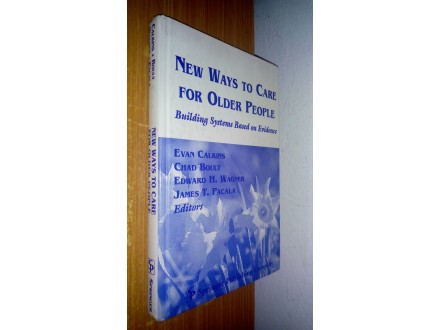New Ways to Care for Older People: Building Systems Bas
| Cena: |
| Stanje: | Polovan bez oštećenja |
| Garancija: | Ne |
| Isporuka: | Pošta Post Express |
| Plaćanje: | Tekući račun (pre slanja) Pouzećem |
| Grad: |
Beograd-Ralja, Beograd-Sopot |
Oblast: Ostalo
ISBN: Ostalo
Godina izdanja: cccc
Jezik: Engleski
Autor: Strani
New Ways to Care for Older People: Building Systems Based on Evidence. Edited by Evan Calkins, Chad Boult, Edward H. Wagner.,
1999g
256 strana
udzbenički format
tvrd povez
ima posvetu,odlično očuvana
The National Service Framework for Older People,1 discussed in last week`s news,2 displays a personality split between its ERG and its IG. An external reference group (ERG) of selected experts offered advice,3 but the framework was written by an “in group” (IG) of civil servants. The IG subserves a political agenda, and that agenda, unchanged over 50 years, is to keep old people out of hospital.
IGians believe that care in proper hospitals is too expensive for old people. This partly reflects a preoccupation with cost per institutional day (money that might be saved by closing something down) rather than with cost per satisfied patient (money properly invested). But savings from putting old people in cheap, ill resourced accommodation are rapidly lost in unnecessarily prolonged lengths of stay, not to mention human misery. IGian fantasies are fed by studies of “inappropriate” use of hospital beds by older people. The definition of inappropriate is contentious, and the term is too readily attached to the patient rather than the treatment. Certainly some older people stay in hospital longer than they want because of the complexities and underfunding of social service care. There are probably many more old people, invisible to IGian research, who would benefit from acute hospital admissions that they are denied. The clearest expression of the IG agenda is the framework`s performance indicator, that demands an annual increase in acute admission rates for people aged over 75 of less than 2%. No evidence is offered to suggest that this percentage will match clinical need. The proposal is institutionalised ageism and effectively betrays IGian moralising against ageism as cant.
The IG seems to misunderstand the logic of medical science. Meta-analyses are not the highest form of evidence in health services research; that position is held by systematic observation of what happens in real life if the proposals generated by research are implemented. It is not enough that a service ought to work, or did so in Orpington, if in practice, or in Slagthorpe, it fails or is irrelevant. The framework demands the creation of a falls service in every centre but without any requirement for local evaluation to see if it works—at least until 2003, when the “achievements” of the service will be documented by means yet to be devised. This reveals a lack of concern for the real world of health care. The opportunity costs of redeploying staff from whatever is now filling their time will vary from place to place. The benefits from replicating service structures developed for a randomised controlled trial will also vary from place to place, not least because of variability in what else is happening locally.
To meet this problem, a topic working group of the central research and development committee, commissioned to recommend priorities for NHS research relevant to the ageing population,3 called for the creation of a development and implementation network of trusts and practitioners. Before new services became imposed as national policy, participants would evaluate them in typical NHS settings; this would inform managers on the real world variance in cost effectiveness. In the framework`s plans for research, this sensible and modernising proposal has been ignored in favour of a purely advisory network, thereby showing, with insouciant irony, the respect civil servants pay to advice.
Similar concern is aroused by the framework`s espousal, again driven by preoccupation with preventing old people from occupying hospital beds, of various hospital at home schemes, despite the variability in costs, acceptability, and effectiveness shown in published trials.
But probably the most worrying feature of the framework is its proposals for developments in intermediate care. An extra 5000 intermediate care beds are to be created. The spirits of geriatricians with long memories will droop. In the 1960s there were many intermediate care beds outside acute hospitals, into which “bed blocking” old people were transferred in the hope that somehow they would disappear from the system. Geriatricians of those days spent their lives getting such beds closed and their staff resources transferred to acute hospitals to provide the specialist rehabilitative care that older people need to get safely and expeditiously home. Specialist geriatric rehabilitation units are crucial elements of comprehensive acute hospital services but are expensive. In medical care, as in anything else, you get what you pay for. It is convenient for managers to confuse convalescence (spontaneous recovery) with the more expensive rehabilitation that is necessary to make non-spontaneous recovery happen. Those geriatricians who have contrived to defend specialist rehabilitation units against the cutbacks of the past 20 years may now have to fight to prevent their being downgraded to intermediate care. Indeed, managers may seek to close rehabilitation units to free money for purchasing intermediate care beds in private sector nursing homes. Those “extra” beds will have to come from somewhere.
Worse yet is the implication, for which the text acknowledges there is no justifying evidence, that older patients could be sent directly to intermediate care, bypassing the skilled diagnostic evaluation that the complexities of disease and disability in old age require.4 This must not be allowed to happen, at least until the unconvincing and overbureaucratic proposals for a single assessment process have been properly evaluated as adequate for the purpose.
https://www.kupindo.com/Drama/80654241_Kapi-kise-u-solji-caja-Roman-Iv-Nikols
Pogledajte naše MAGNETNI BUKMARKERI :
https://www.kupindo.com/Ostalo/78848793_Magnetni-Bookmarkeri-Bukmarkeri-Obelezivaci-strana
POPUST!!!
Potrebno je da ispunjavate sva 3 uslova popusta:
1. Popust NE VAZI za knjige čija je pojedinačna cena preko 490 dinara i ne važi za komplete knjiga
2. Ako odlučite da kupite knjige (koje nisu skuplje od 490 din i nisu kompleti) u vrednosti od minimum 2000 dinara , PRVO me kontaktirajte preko KUPINDO poruka (da bih korigovala cene) i DOBICETE POPUST OD 10%
U poruci napišite: Svrha poruke - Popust
Obavezan spisak knjiga sa cenama pre kupovine
3. Popust NE važi NAKON sto obavite kupovinu vec isključivo PRE nego sto počnete da kupujete
*****************************************************************
Pakovanje naplaćujemo 10 dinara po pošiljci
*********************************************************************
Knjige saljemo:
- kao preporucene tiskovine NE ŠALJEMO KNJIGE KAO OBIČNU TISKOVINU
- kao paket - plaćate knjige i poštarinu UNAPRED, NEMA OPCIJE da poštarinu za paket platite prilikom preuzimanja
- post expresom Plaćanje POUZEĆEM znači da šaljemo POST EXPRESOM (NE ŠALJEMO CC paket pouzećem)
- Ako šaljemo pošiljku na adresu firme post expres insistira na nazivu firme koji se piše u napomeni
Postoji mogućnost da nema opcije post expresa:
- ako kupac ima negativne ocene
- u specifičnim slučajevima ako zaključimo da kupac nije pouzdan - nepostojeći broj telefona, knjiga mora stići u određenom roku zbog putovanja i sl.
****************************************************
Ne šaljemo knjige u inostranstvo tj izvan Srbije
Naše knjige pogledajte: http://www.kupindo.com/Clan/IvanaIg/SpisakPredmeta
Pogledajte našu ponudu Magnetni Bookmarkeri
https://www.kupindo.com/Ostalo/78848793_Magnetni-Bookmarkeri-Bukmarkeri-Obelezivaci-strana
i
https://www.kupindo.com/Ostalo/78848877_Magnetni-Bookmarkeri-Bukmarkeri-Obelezivaci-strana
Predmet: 69948809











